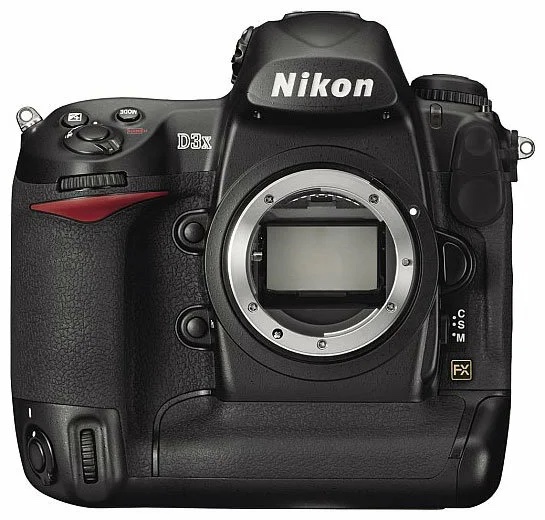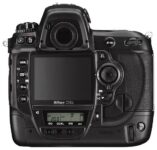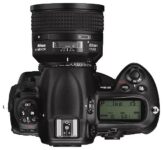Announced
Production status
System
Nikon F system cameras
- Nikkorex F
- Nikkormat EL
- Nikkormat ELW
- Nikkormat FS
- Nikkormat FT
- Nikkormat FT2
- Nikkormat FT3
- Nikkormat FTN
- Nikon D3
- Nikon D3s
- Nikon D3X
- Nikon D4
- Nikon D4s
- Nikon D5
- Nikon D6
- Nikon D600
- Nikon D610
- Nikon D700
- Nikon D750
- Nikon D780
- Nikon D800
- Nikon D800E
- Nikon D810
- Nikon D850
- Nikon Df
- Nikon EL2
- Nikon EM
- Nikon F
- Nikon F100
- Nikon F2
- Nikon F3
- Nikon F4
- Nikon F5
- Nikon F6
- Nikon FA
- Nikon FE
- Nikon FE10
- Nikon FE2
- Nikon FG
- Nikon FG-20
- Nikon FM
- Nikon FM10
- Nikon FM2
- Nikon FM2/T
- Nikon FM3A
- Nikon N2000
- Nikon N2020
- Nikon N4004
- Nikon N4004S
- Nikon N50
- Nikon N5005
- Nikon N55
- Nikon N60
- Nikon N6000
- Nikon N6006
- Nikon N65
- Nikon N70
- Nikon N75
- Nikon N80
- Nikon N8008
- Nikon N8008S
- Nikon N90
- Nikon N90S
Nikon D3X
35mm AF digital SLR camera • Discontinued
Specification
| Format: | |
| 35mm full frame | |
Imaging sensor: | 35.9 × 24mm CMOS sensor |
Resolution: | 6048 × 4032 - 24 MP |
Sensor-shift image stabilization: | - |
| Nikon F [46.5mm] | |
| Shutter: | |
Type: | Focal-plane |
Model: | Electronically controlled |
Speeds: | 30 - 1/8000 + B |
| Exposure: | |
Exposure metering: | Through-the-lens (TTL), open-aperture |
Exposure modes: | Programmed Auto |
| Aperture-priority Auto | |
| Shutter-priority Auto | |
| Manual | |
| Physical characteristics: | |
Weight: | 1220g |
Dimensions: | 159.5x157x87.5mm |
Manufacturer description
TOKYO — Nikon Corporation is pleased to announce the introduction of the Nikon D3X digital SLR. This exciting new camera employs a Nikon FX-format CMOS imaging sensor (35.9 x 24.0 mm) with an imaging area equivalent to 35mm film, and its 24.5 effective megapixels deliver images of striking quality and resolution.
Designed to meet the demands of a growing multitude of serious professionals, such as studio photographers, for whom exquisite detail is a vital part of their work, the D3X achieves resolution comparable to medium-format cameras — with an entirely new level of operating ease. It's perfect for the broadest range of detailed work, from fashion and product shootings, to weddings, architecture, landscapes and large poster production. And it shares the robust body structure of the D3, for superior mobility and operation in virtually any shooting environment, indoors or out.
- Newly developed Nikon FX-format CMOS sensor (35.9 x 24.0 mm sensing area)
- 24.5 million effective pixels
- Superior-resolution image quality equivalent to medium-format digital cameras
- High-speed continuous shooting of up to approx. 5 frames per second in FX format (24.5 megapixels) / 5:4 (20.4 megapixels); 7 frames per second in DX format (10.5megapixels)*1
- Wide ISO sensitivity of 100 to 1600 at normal setting, with low noise performance
- Two Live View modes — Handheld and Tripod
- High-density 51-point (world's largest number*2) AF system
Development background
The Nikon D3 digital SLR, released November 2007, has garnered glowing tributes for image quality, sensitivity and speed performance from leading professional photographers throughout the world. This stunning success has prompted a mounting demand for a similar Nikon model that would offer a greater pixel count and higher resolution. A camera that would provide superb mobility and ergonomics while offering image quality equivalent to medium-format digital cameras.
In response to these requests, Nikon has developed the D3X, an exciting new digital SLR with a Nikon FX-format CMOS sensor (35.9 x 24.0 mm sensing area) that delivers 24.5 effective megapixels, uses the same body structure as the D3, and boasts the same outstanding mobility and operability.
Major features
1. Nikon FX-format CMOS sensor with 24.5 megapixels
The D3X employs a new Nikon FX-format CMOS sensor with 24.5 effective megapixels covering an area of 35.9 x 24.0 mm to achieve truly amazing resolution. What's more, we've optimized the pixel characteristics to provide a higher S/N ratio and wider dynamic range by securing a greater amount of light received by each pixel, thereby reducing lost highlights and shadows, and ensuring smoother tone reproduction with minimized noise.
2. Wide sensitivity range starting at ISO 100
At normal setting, the D3X offers a wide range of sensitivity — from ISO 100, suitable for stroboscopic setting in studio shoots, to ISO 1600. It realizes superior image quality with less noise at ISO 1600 as well as at low sensitivity settings. What's more, the sensitivity range can be increased by two stops (up to ISO 6400 equivalent) and decreased by one stop (down to ISO 50 equivalent), offering an even greater diversity of shooting possibilities. Auto sensitivity control is also available.
3. New EXPEED-based image processing
A new image processing system, based on Nikon's comprehensive EXPEED digital image processing and specially optimized for the D3X, provides superior image quality, faster processing speeds and lower power consumption. This advanced system achieves precise color reproduction for the broadest spectrum of hues, plus vivid saturation and smooth gradation, conveying colors as you see them, even with the slight changes in color tones you perceive. Furthermore, Nikon's advanced noise processing function, which was designed to minimize noise occurrence, achieves this without interfering with other factors, including hue.
4. High-speed performance meets the most rigorous professional demands
Just like the D3, the D3X achieves a start-up time of 0.12 second*1 and a shutter release time lag of 0.04 second*3*4. It delivers a continuous shooting speed of approx. 5 frames per second in FX format (36 x 24) or 5:4 (30 x 24), and 7 frames per second in DX format (24 x 16)*4*5. Also, the D3X is fully compatible with UDMA, the new-generation high-speed card that enables 35 MB recording equivalent to the D3. The D3X is capable of recording approx. 7.1 MB (JPEG, image size L, NORMAL) of data captured in FX format at speeds of approx. 5 frames per second.
5. Realizing reliable auto control: Scene Recognition System
As with the D3, the D3X recognizes subjects and shooting scenes using a 1,005-pixel RGB sensor that precisely controls exposure by detecting not only the brightness but the colors of the subjects as well. The results are applied to control Autofocus, Auto Exposure, i-TTL Balanced Fill-flash and Auto White Balance, thereby achieving control of the highest.
6. AF system employing high-density 51-point AF
The Multi-CAM 3500FX autofocus sensor module, originally incorporated in the D3, offers proven outstanding performance. All 51 focus points, including the 15 cross-type sensors located at the center, are effective in all AF NIKKOR lenses with a maximum aperture of f/5.6 or larger. Three AF-area modes — Single point, Dynamic-area AF and Auto-area AF — are available to maximize the use of the 51 focus points by selecting the most suitable one to match subject conditions. Moreover, in Scene Recognition System, subject identification and tracking information is applied to improve subject acquisition performance in Dynamic-area AF mode and focusing accuracy for human subjects in Auto-area AF mode.
7. Superior durability
Magnesium alloy is used for the exterior cover, chassis and mirror box to ensure light weight and rugged reliability. Strict O-ring sealing at critical connected parts effectively restricts dust and moisture. The shutter unit, developed and manufactured by Nikon, employs a new material (carbon fiber/Kevlar® hybrid) for the shutter blades, guaranteeing excellent durability through 300,000-cycle release tests with the shutter actually loaded. Precision is also maintained with a shutter monitor.
8. High-resolution 3-inch LCD monitor with approx. 920k-dots (VGA), 170° wide-viewing angle and reinforced glass
The D3X incorporates a large, 3-inch LCD monitor with ultra-high resolution of approx. 920k-dots (VGA). Enlarged playback images also appear in extremely high resolution for easy focus confirmation. The wide viewing angle of 170° makes it easy to check composition in Live View shooting for both high and low angles.
9. Two Live View modes available
In Handheld mode, which allows the frame to be recomposed prior to actual shooting, ordinary TTL phase-difference AF using all 51 AF points is activated. Tripod mode is designed for precise focus with still subjects and tripod stabilization; it allows focal-plane contrast AF on a desired point within a specific area. Optional software Camera Control Pro 2 enables monitor focus and control shutter release from a computer. And optical Wireless Transmitter WT-4 enables wireless remote camera control and image transfer.
10. Picture Control System
Picture Control System offers four kinds of Picture Controls: Standard, Neutral, Vivid, and Monochrome. Choose one and use as is, or adjust image creation factors (Sharpening, Contrast, Brightness, Saturation, and Hue). Optional Picture Controls (Portrait, Landscape, D2XMODE I, D2XMODE II and D2XMODE III) are available at the Nikon website for downloading and installation to your camera.
11. Active D-Lighting — reproducing brightness as you see it
In settings with strong contrast, Active D-Lighting, used in combination with 3D Matrix Metering II, determines an exposure by utilizing a gradation of highlights, detects lost shadows, then reproduces them after digital processing. Rather than simply expanding the dynamic range, Active D-Lighting prevents images from looking flat through localized tone control technology, and creates realistic contrast while compensating lost shadows and highlights. Choose from Auto, Extra High, High, Normal, Low or Off setting prior to shooting.
12. Electronic virtual horizon
An accelerator sensor incorporated in the body of the camera detects inclination and displays it in the LCD monitor. In Live View shooting, virtual horizon is displayed in the LCD above the monitor image. It can also be displayed in the top control panel and in the exposure indicator of the viewfinder.
13. UDMA-compatible memory card double slot
The CompactFlash (CF) card slots are UDMA-compatible for high-speed data transfer. With the double slot, you can choose from Continuous recording, Backup recording, and RAW + JPEG Separation recording (records the same image in RAW and JPEG on different cards). You can also copy the data from one card to another.
14. GPS Unit GP-1 (optional)
GPS records shooting information such as latitude, longitude, altitude and date of shooting. Coordinated with map information, you can create an original map using images.
Other features
- Lateral chromatic aberration reduction creates images with a clear periphery using original image processing technology to significantly reduce color aberrations
- Vignette Control effectively prevents reduction of light at the periphery
- Optical viewfinder achieves approx. 100%*6 frame coverage and 0.7x*7 magnification in FX format
- Three sensing areas: FX format (36 x 24), DX format (24 x 16), and 5:4 (30 x 24)
- Customizable function button
- Choice of black or white letters for shooting information display
- AF fine adjustment with professional standard of accuracy
- Compliant with HDMI™ for high-definition image playback
- Lets you shoot up to approx. 4,400 frames on a single battery charge
Similar cameras (2)
35mm full frame • Auto focus • Digital • Singe-lens reflex • Nikon F mount
| Model | Shutter | Metering | Modes | Year |
|---|---|---|---|---|
| Kodak DCS Pro 14n | E, 1/4000 | TTL • OA | PASM | 2002 ● |
| Kodak DCS Pro SLR/n | E, 1/4000 | TTL • OA | PASM | 2004 ● |


